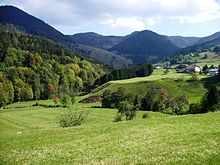Came

A kame (from Scottish kame = steep hill made of loose material) is an elevation within glacial landfill landscapes that was created by the deposition of ice and its meltwater on the edge of the ice against an abutment. Abutments can be blocks of dead ice , valley slopes or other slopes. The later melting of the dead ice allows the came to appear as a full form.
The meltwater rivers poured on or against the abutment, e.g. B. Dead ice, sand and gravel . Fine-grained deposits that have formed in ice reservoirs are also widespread . Kames therefore belong to the glacifluvial as well as the glacilimnic forms.
Kames belong to the small forms of the glacial series and are part of the ground moraine landscape . In contrast to the elongated Oser trains , Kames have a more irregular or rounded floor plan and are not wall-like, but rather have a back or dome shape. Steeper side slopes often limit a flatter plateau. Their height is between a few and a few dozen meters; their area ranges from a few hundred square meters to a few hectares.
Related to the Kames are Kamesterrassen, where the abutment is always formed by a valley slope. Kamesterrassen are mainly found in formerly heavily glaciated mountains like the Alps .
Came Hill
An example of glacifluviatile deposits are Kameshügel, accumulations of rounded to rounded smaller material in which the fine fraction is missing.
They arise when debris from the upper moraine is washed into crevasses and accumulates there, whereby the fine fraction is washed out as part of the glacial milk. If the glacier now thaws back, the Kameshügel remains as a deposit of the coarser material. Kameshügel can only be found near valley glaciers, as only these have an upper moraine.
See also
literature
- Frank Ahnert: Introduction to Geomorphology (= UTB . 8103). 3rd, updated and supplemented edition. Eugen Ulmer, Stuttgart 2003, ISBN 3-8001-2813-6 .
- Georg Schulz: Lexicon for determining the landforms in maps (= Berlin Geographical Writings. 28). Institute for Geography of the Technical University of Berlin, Berlin 1989, ISBN 3-7983-1283-4 .
Web links
- Came in Spectrum - Encyclopedia of Geosciences
